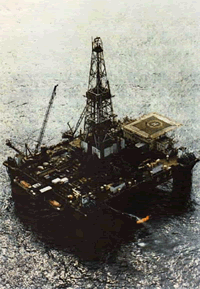#061 Corrosion Fatigue
Corrosion Fatigue is a facture phenomenon occurring when repeated stresses are applied on metals in corrosive environments. As with the Stress Corrosion Fracture phenomenon, this does not occur with either stresses or corrosion alone, but both must exist simultaneously.
Let us suppose what metal fatigue is. A wire as an example, will break if repeatedly bent and straightened. This occurs because the metal is fatigued and resulted in a fracture due to stress build-up by repeated bending.
There are many objects that receive the repeated stress in the real world. Railway bridges are subjected to stress every time a train passes, and marine structures such as bridges receive large cyclic stresses when hit by waves. Pressure bulkheads of large aircrafts are subjected to stresses caused by air pressure differentials on take-offs. The metal fatigue occurs in atmosphere, in vacuum, and in water.
Based on investigations into how applied stresses and frequencies affect metal fractures, it is found that metals fracture only with a few bend repetitions if the applied stresses exceed certain limits. This limit is called "Fatigue Limit". When applied stresses are below Fatigue Limits, metals do not fracture even if repeatedly exposed to the stresses. This fact establishes an important indices for designs on machines and equipment that are exposed to repeated stresses.
However, metals can fracture when exposed to repeated stresses at even less than the Fatigue Limit if a corrosive environment is combined. Also, fractures can occur with less repetition cycles at the same stress levels. This means that Fatigue Limit disappears. In other words, metal will fracture, regardless of repeated stress levels, if enough repeated stresses are applied. This is called "Corrosion Fatigue".
|
In marine structure designing, it is important to design with close attention to metal's corrosion fatigue characteristics. But the metals used are typically all steel alloys, and it is difficult to improve the corrosion fatigue characteristics of steel alloys. For the fatigue factor alone, it suffices to use materials with high fatigue limits, but anti-corrosion property must also be taken in consideration for the corrosion fatigue factor. Although it is not impossible to improve materially, but only within limited ranges.
Therefore, the important design approach would be to minimize features and locations where stresses would concentrate, or reduce the amounts of stress concentrations. Marine structures for an example, many small diameter steel tubes are driven into the ground and weld connected to the main support columns, and used as sacrificial corroding member as a countermeasure. Some electrical anti-corrosion measures as explained in a later discussion are in use also. |
 |
- Environmental conservation
- Hot Dipping
- Anodic Oxidation Process
- Anodic oxidation treatment
- Anodizing
- Corrosion - Corrosion Protection
- Electroless Plating
- Electroplating
- Heat treating
- Hydrogen embrittlement
- Metal cleaning
- Metal etching
- Painting
- Special paints
- Surface Treatment
- Surface-treated steel sheets
- Thermal Spraying



